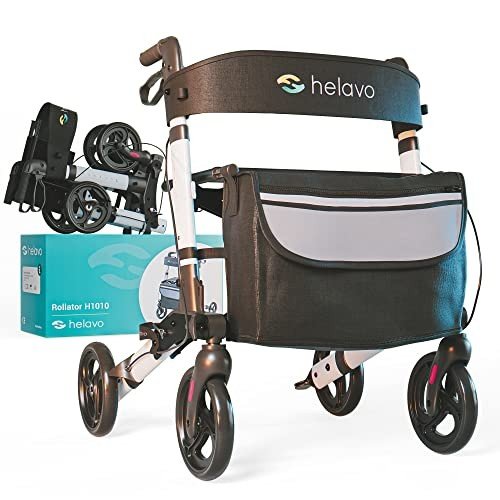
Collapsible Rollator
Add a review FollowOverview
-
Founded Date November 2, 1981
-
Posted Jobs 0
-
Viewed 33
Company Description
“The Lightweight Walker Awards: The Most, Worst, And The Most Unlikely Things We’ve Seen

The Lightweight Walker: A Comprehensive Guide
Introduction
Lightweight walkers are necessary mobility aids designed to help individuals who have difficulty walking or maintaining balance. Unlike traditional walkers, which can be cumbersome and heavy, lightweight walkers offer boosted portability and ease of use. This article explores the features, benefits, and different kinds of lightweight walkers available, making it an important resource for people seeking enhanced mobility, caretakers, and healthcare specialists.
Comprehending Lightweight Walkers
Lightweight walkers are usually built from materials such as aluminum or carbon fiber. Their design prioritizes both durability and ease of transport and use. The advancement in engineering and manufacturing methods has actually caused the advancement of designs that can be easily maneuvered, making them suitable for a broad range of users.
Key Features of Lightweight Walkers
- Material: Most lightweight walkers are made from high-strength aluminum or carbon fiber, making them easy to lift and transport.
- Foldability: Many models feature a folding style for hassle-free storage and transport.
- Weight Capacity: Despite their lightweight nature, they are built to sustain considerable weight while maintaining stability.
- Adjustable Height: Most walkers provide adjustable height settings to accommodate users of varying heights.
- Brakes and Wheels: Some designs consist of wheels for increased mobility, as well as brakes for safety when resting.
Here’s a contrast table of some popular models of lightweight walkers to help users make notified choices:
| Model | Weight | Weight Capacity | Features | Cost Range |
|---|---|---|---|---|
| Drive Medical 10210-1 | 5 lbs | 300 pounds | Foldable, non-slip hand grips, lightweight | ₤ 60 – ₤ 80 |
| Nova 4200 | 8 lbs | 250 lbs | 8″ wheels, an integrated seat, and adjustable | ₤ 120 – ₤ 150 |
| Medline E0302 | 7 lbs | 300 pounds | Side folding, 5″ wheels, and ergonomic grips | ₤ 70 – ₤ 100 |
| Hugo Folding Walker | 6 pounds | 300 pounds | Adjustable height, consists of backrest seat | ₤ 80 – ₤ 110 |
| Mego Mobility Walker | 8 pounds | 350 lbs | Dual brakes, adjustable arms, addition of a basket | ₤ 90 – ₤ 130 |
Benefits of Lightweight Walkers
Lightweight walkers use numerous advantages to users, boosting both mobility and quality of life. A few of the notable benefits include:
- Improved Mobility: They help individuals ambulate safely and confidently, allowing them to participate in day-to-day activities and preserve self-reliance.
- Reduce of Transport: The lightweight nature and collapsible style make them simple to transfer in cars and trucks or public transport.
- Customization: Many walkers allow for height adjustments, ensuring a comfortable fit customized to the user.
- Improved Stability: These walkers supply the assistance needed to assist avoid falls and injuries, especially in older adults.
- Variety of Designs: With a series of styles offered, users can pick walkers that best fit their individual choices and needs.
Types of Lightweight Walkers
-
Standard Walkers: Basic designs developed generally for stability with rubber suggestions, offering stability however limited mobility.
-
Two-Wheeled Walkers: Equipped with front wheels, these walkers offer boosted maneuverability while still providing support.
-
Four-Wheeled Walkers (Rollators): These walkers feature wheels on all four legs, making them much easier to browse over various surface areas. Lots of also consist of a seat, supplying rest during long getaways.
-
Tri-Wheeled Walkers: Ideal for users who need more dexterity in tight areas, tri-wheel styles are compact yet sturdy.
Selecting the Right Lightweight Walker
When picking a lightweight walker, consider the list below elements:
- User’s Weight and Height: Ensure the walker can accommodate the user’s size effectively.
- Planned Use: Understand where the walker will be mainly utilized (indoors vs. outdoors) and select wheels appropriately.
- Frequency of Use: For those utilizing the walker daily, comfort features, such as grips and seat choices, may be necessary.
- Safety Features: Look for designs with sufficient brakes or locking mechanisms to guarantee stability.
Often Asked Questions
Q1: Are lightweight walkers more costly than conventional walkers?A1: Generally, lightweight walkers can be slightly more costly than standard walkers due to their advanced products and functions, however they use substantial benefits in mobility and ease of use. Q2: Can I use a lightweight walker if I have considerable
mobility issues?A2: Yes, lightweight walkers are appropriate for various mobility levels.
Nevertheless, it’s suggested to speak with a doctor or physical therapist for personalized recommendations. Q3: Do lightweight walkers come with warranties?A3: Most trusted makers offer service warranties, typically
ranging from one to 3 years, but it’s necessary to
examine specific item details. Q4: How do I keep my lightweight walker?A4: Regularly examine for wear on wheels, brakes, and grips. Tidy the walker with a damp
fabric and avoid exposure to harsh chemicals. Q5: Are there options for tailoring lightweight walkers?A5: Yes, lots of makers provide adjustable features such as color alternatives, attachment of bags, and seat cushions
. Lightweight walkers are vital mobility aids that improve independence
, stability, and lifestyle for lots of individuals. Comprehending the numerous functions, benefits, and types
available can assist users make notified choices. By picking the best walker, individuals will find they can navigate their surroundings with self-confidence and ease. As the population continues to age, lightweight walkers will remain important tools for mobility, guaranteeing that everyone retains their flexibility to move safely and efficiently.
